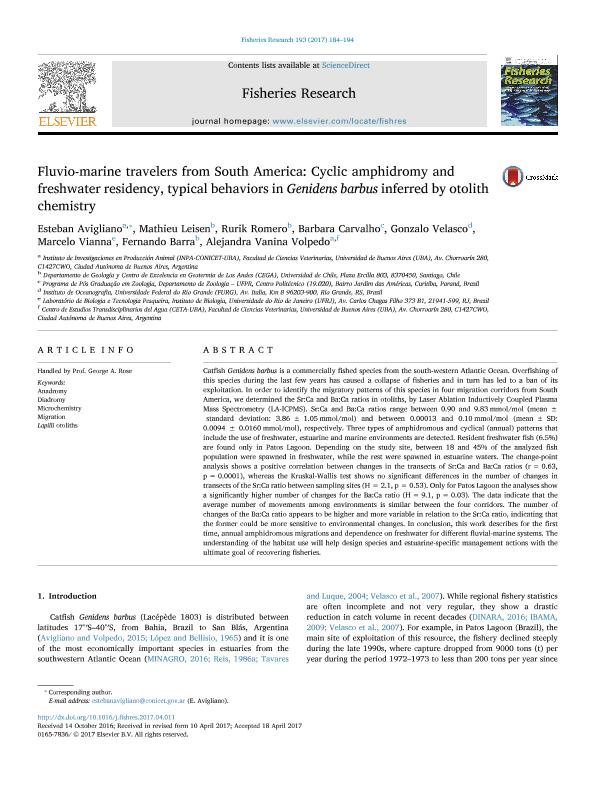Mostrar el registro sencillo del ítem
dc.contributor.author
Avigliano, Esteban

dc.contributor.author
Leisen, Mathieu
dc.contributor.author
Romero, Rurik
dc.contributor.author
Carvalho, Barbara
dc.contributor.author
Velasco, Gonzalo
dc.contributor.author
Vianna, Marcelo
dc.contributor.author
Barra, Fernando
dc.contributor.author
Volpedo, Alejandra

dc.date.available
2018-11-28T17:50:06Z
dc.date.issued
2017-09
dc.identifier.citation
Avigliano, Esteban; Leisen, Mathieu; Romero, Rurik; Carvalho, Barbara; Velasco, Gonzalo; et al.; Fluvio-marine travelers from South America: cyclic amphidromy and freshwater residency, typical behaviors in Genidens barbus inferred by otolith chemistry; Elsevier Science; Fisheries Research; 193; 9-2017; 184-194
dc.identifier.issn
0165-7836
dc.identifier.uri
http://hdl.handle.net/11336/65462
dc.description.abstract
Catfish Genidens barbus is a commercially fished species from the south-western Atlantic Ocean. Overfishing of this species during the last few years has caused a collapse of fisheries and in turn has led to a ban of its exploitation. In order to identify the migratory patterns of this species in four migration corridors from South America, we determined the Sr:Ca and Ba:Ca ratios in otoliths, by Laser Ablation Inductively Coupled Plasma Mass Spectrometry (LA-ICPMS). Sr:Ca and Ba:Ca ratios range between 0.90 and 9.83 mmol/mol (mean ± standard deviation: 3.86 ± 1.05 mmol/mol) and between 0.00013 and 0.10 mmol/mol (mean ± SD: 0.0094 ± 0.0160 mmol/mol), respectively. Three types of amphidromous and cyclical (annual) patterns that include the use of freshwater, estuarine and marine environments are detected. Resident freshwater fish (6.5%) are found only in Patos Lagoon. Depending on the study site, between 18 and 45% of the analyzed fish population were spawned in freshwater, while the rest were spawned in estuarine waters. The change-point analysis shows a positive correlation between changes in the transects of Sr:Ca and Ba:Ca ratios (r = 0.63, p = 0.0001), whereas the Kruskal-Wallis test shows no significant differences in the number of changes in transects of the Sr:Ca ratio between sampling sites (H = 2.1, p = 0.53). Only for Patos Lagoon the analyses show a significantly higher number of changes for the Ba:Ca ratio (H = 9.1, p = 0.03). The data indicate that the average number of movements among environments is similar between the four corridors. The number of changes of the Ba:Ca ratio appears to be higher and more variable in relation to the Sr:Ca ratio, indicating that the former could be more sensitive to environmental changes. In conclusion, this work describes for the first time, annual amphidromous migrations and dependence on freshwater for different fluvial-marine systems. The understanding of the habitat use will help design species and estuarine-specific management actions with the ultimate goal of recovering fisheries.
dc.format
application/pdf
dc.language.iso
eng
dc.publisher
Elsevier Science

dc.rights
info:eu-repo/semantics/openAccess
dc.rights.uri
https://creativecommons.org/licenses/by-nc-sa/2.5/ar/
dc.subject
Anadromy
dc.subject
Diadromy
dc.subject
Lapilli Otoliths
dc.subject
Microchemistry
dc.subject
Migration
dc.subject.classification
Otras Ciencias Biológicas

dc.subject.classification
Ciencias Biológicas

dc.subject.classification
CIENCIAS NATURALES Y EXACTAS

dc.subject.classification
Agricultura

dc.subject.classification
Agricultura, Silvicultura y Pesca

dc.subject.classification
CIENCIAS AGRÍCOLAS

dc.title
Fluvio-marine travelers from South America: cyclic amphidromy and freshwater residency, typical behaviors in Genidens barbus inferred by otolith chemistry
dc.type
info:eu-repo/semantics/article
dc.type
info:ar-repo/semantics/artículo
dc.type
info:eu-repo/semantics/publishedVersion
dc.date.updated
2018-10-23T20:27:21Z
dc.journal.volume
193
dc.journal.pagination
184-194
dc.journal.pais
Países Bajos

dc.journal.ciudad
Amsterdam
dc.description.fil
Fil: Avigliano, Esteban. Consejo Nacional de Investigaciones Científicas y Técnicas. Oficina de Coordinación Administrativa Parque Centenario. Unidad Ejecutora de Investigaciones en Producción Animal. Universidad de Buenos Aires. Facultad de Ciencias Veterinarias. Unidad Ejecutora de Investigaciones en Producción Animal; Argentina
dc.description.fil
Fil: Leisen, Mathieu. Universidad de Chile; Chile
dc.description.fil
Fil: Romero, Rurik. Universidad de Chile; Chile
dc.description.fil
Fil: Carvalho, Barbara. Universidade Federal do Paraná; Brasil
dc.description.fil
Fil: Velasco, Gonzalo. Universidade Federal do Rio Grande do Sul; Brasil
dc.description.fil
Fil: Vianna, Marcelo. Universidade Federal do Rio de Janeiro; Brasil
dc.description.fil
Fil: Barra, Fernando. Universidad de Chile; Chile
dc.description.fil
Fil: Volpedo, Alejandra. Consejo Nacional de Investigaciones Científicas y Técnicas. Oficina de Coordinación Administrativa Parque Centenario. Unidad Ejecutora de Investigaciones en Producción Animal. Universidad de Buenos Aires. Facultad de Ciencias Veterinarias. Unidad Ejecutora de Investigaciones en Producción Animal; Argentina. Universidad de Buenos Aires. Facultad de Ciencias Veterinarias. Centro de Estudios Transdisciplinarios del Agua; Argentina
dc.journal.title
Fisheries Research

dc.relation.alternativeid
info:eu-repo/semantics/altIdentifier/doi/https://dx.doi.org/10.1016/j.fishres.2017.04.011
dc.relation.alternativeid
info:eu-repo/semantics/altIdentifier/url/https://linkinghub.elsevier.com/retrieve/pii/S0165783617301169
Archivos asociados
